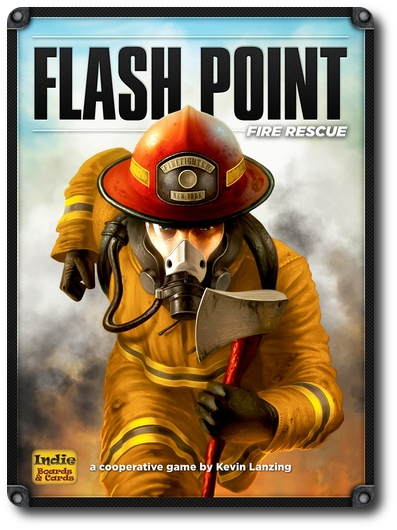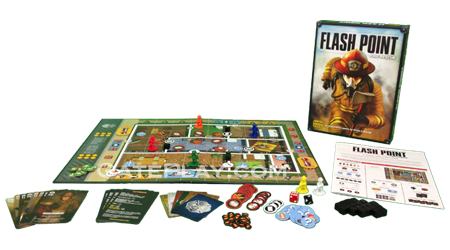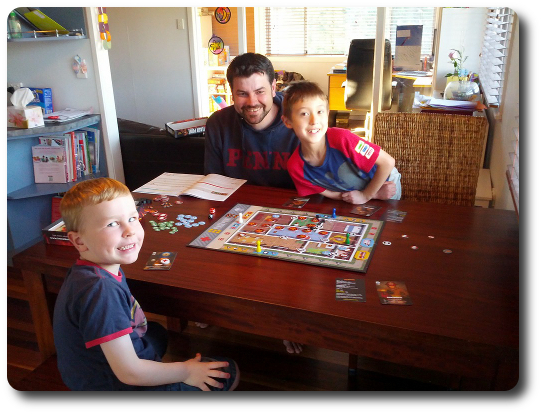
The Basics:
- Ages 8 and up (publisher recommends 10+)
- For 1 to 6 players
- Approximately 45 to 60 minutes to complete
Geek Skills:
- Active Listening & Communication
- Counting & Math
- Logical & Critical Decision Making
- Reading
- Strategy & Tactics
- Cooperative & Team Play
- Self-confidence
Learning Curve:
- Child – Moderate
- Adult – Moderate
Theme & Narrative:
- Work together with your fellow firefighters to rescue pets and their owners from the burning house!
Endorsements:
- Gamer Geek approved! (for a limited time only)
- Parent Geek approved!
- Child Geek approved!
Overview
Most children dream of being a fireman when they grow up, but why wait? Flash Point: Fire Rescue is a cooperative game about rescuing victims from a burning building. As with other cooperative games, success depends on a clear division of responsibilities, as well as a touch of good fortune. Played in a supportive environment, this game will help build your little geek’s self-confidence and communication skills. While it does not differ greatly from other cooperative games, its theme and tense game play warrant a Father Geek seal of approval!
Flash Point: Fire Rescue, designed by Kevin Lanzing and published by Indie Boards & Cards with Kickstarter funding in 2011, is a cooperative game about firefighting. It draws inspiration from other cooperative titles like Pandemic and Forbidden Island, most notably in the implementation of variable player powers. The aim is to rescue the occupants of a burning building before it collapses, and the challenge is to work together, making the most of each specialist’s strengths to achieve victory.
The game board is double-sided, depicting two versions of a floor plan of a burning house with a superimposed 8×6 grid. The game board also has a track around the perimeter in which the ambulance and the fire engine travel. Other components include:
- Cardboard markers representing Hot Spots, Fire/Smoke, Hazardous Materials, Doors, Vehicles, Points of Interest, Healing and spare Actions
- Black wooden cubes representing structural damage to walls
- 6 colored pawns representing firefighters
- Cards outlining the characteristics of each specialist firefighter, as well as player aid cards
- Two standard dice, one 6-sided and one 8-sided

Suffice to say that the components are colorful, attractive, and appear durable. The game bits are not fire-retardant.
Game Set Up
The basic “Family” game is described here. The board is seeded with 10 Fire markers at specified locations. Points of Interest (POI, most of which are victims that require rescuing, but some of which are blank False Alarms) are mixed face-down and 3 are placed on the game board at specified locations. Each player chooses a firefighter pawn and places it at a starting location outside the building.
So much for prep! Time to fight a fire!
It’s … Hosing Time?
The game is played in rounds with game play proceeding in clockwise order. On their turn, a player completes the three following phases:
Take Action
During this phase, the player uses up to 4 Action Points (AP) per turn to move, open or close doors, extinguish fires, or chop through walls. The cost of each action (1 or 2 AP) is listed on the player aid card. For instance, moving into a clear space costs 1 AP, but moving into a space with fire costs 2 AP and moving while carrying a victim also costs 2 AP. If a firefighter moves into a space with a POI, it is flipped over (for no AP cost) to reveal whether it is a victim or a false alarm. Victims must be carried outside the building in order to be rescued. Unspent AP can be saved for the next turn, to a maximum of 4 saved AP.
Advance Fire
Now is when all your hard work is undone! Roll both dice to determine coordinates for placing a Smoke marker. If there is already smoke or fire at or adjacent to that location, this may be upgraded to a fire, or even worse, an explosion! If fire advances into a POI-occupied space, the POI becomes a casualty (pray it was only a false alarm!). If fire advances into a firefighter-occupied space, the firefighter is knocked down and is immediately moved outside the building to recover. Explosions may cause damage to walls, represented by placing damage markers in the appropriate places.
Replenish POI
During this phase, if there are fewer than 3 POIs on the game board (identified or unidentified), place new POI on a location determined by rolling the dice and remove any smoke or fire on the space.
End of Game
The players win if they rescue 7 victims. The players lose if 4 victims become casualties or if the building collapses by acquiring 24 damage markers on the game board.
But You Promised There’d Be Variable Player Powers!
The “Experienced” game adds considerable chrome to the basic framework outlined above. Players take on one of 8 specialist firefighter roles. Each role has a unique ability, such as discounted AP costs for certain actions. Initial seeding of fire is randomized according to one of three levels of difficulty. Other additional features include:
- Hazmats that increase the risk of explosions, the occupants of this building were not particularly safety-conscious!
- Hot spots that increase the spreading of fire, making it more difficult to keep it under control
- The option of healing victims so that they need not be carried to safety
The ambulance and fire engine are represented by cardboard counters that can be moved around the building as needed. Victims must be brought to the ambulance for rescue. The fire engine has a deck gun with which firefighters may try to extinguish multiple fire locations at once, although its effectiveness is very random!
In short, the Experienced game is more lethal than the Family game, even at the lowest difficulty setting, but there are more options for expending AP and the firefighters are more powerful. These add just enough flavor and complexity to the game to make it a worthwhile cooperative exercise.
To learn more about Flash Point: Fire Rescue, visit the game’s official web page.
Prediction
My children and I love playing Forbidden Island and Pandemic, especially for the discussions about coordinating our efforts. A potential pitfall in many cooperative games is the “dominant personality”, where one player gives everyone else their marching orders. We ensure that this does not happen by taking an unrushed approach, so that everyone has the chance to chime in with a suggestion. It is heart-warming to see my children demonstrate assertiveness and respect in equal measure, and it is an excellent tool for building self-confidence and communication skills.
Flash Point: Fire Rescue, with its firefighting theme, is sure to be a hit with the young ones. I had played the game once before with other adult gamers and we found it entertaining, although we questioned its long-term replayability for more serious gamers.
Final Word
My first foray into playing Flash Point: Fire Rescue with children involved a gamer geek buddy of mine and our sons. His son, age 5, had played the game before, while my son, 7, had not. I do not recall which difficulty level we selected, but I do remember that we failed to achieve 7 rescues before the building collapsed in a flaming heap. The game lived up to its promise in terms of tension. I could see that my son remained highly focused throughout. My buddy’s son lost interest halfway through and wandered off to join my daughter who was jumping on the trampoline. Clearly the gaming genes are weak in my buddy’s family!
Child Geeks will be enthralled by the theme. As we experienced, the game requires reasonable maturity in terms of concentration span and sense of purpose, so children younger than 8 will likely need significant assistance from parents to decide how to expend AP. Still, I need not remind you that being a fireman is a pretty exciting prospect at this age, even more so if it is done from the comfort of your air-conditioned home!

Firefighting is a happy business apparently
Parent Geeks should jump at the chance to see their little geeks apply and refine their puzzle-solving and communication skills. But there is a risk that you may be having too much fun playing the game to notice! Personally, I enjoy the game on both levels, so be sure to encourage, reflect, and above all, take your time.
Gamer Geeks will find this challenging on the first few plays, but may lose interest once they have formulated an “ideal” strategy. So it is with other purely cooperative games. As a result, hard-core gamers are more likely to enjoy semi-cooperative games, with or without traitors, which add unpredictability and uncertainty by means of a human adversary. Nevertheless, this is still a fine game to bring out on the occasional game night, providing a rewarding and enjoyable change of pace in between heavier games.
Is it worth purchasing this game if you already own Pandemic or Forbidden Island? I am inclined to say no, because there is considerable overlap in game play. And yet, even though I own Forbidden Island and still play it regularly, I wish I owned the other two as well! It’s a good thing my gaming buddy owns both of them and is happy to lend them to me. Just don’t tell him what I said about his gaming genes.
Discover more from Father Geek
Subscribe to get the latest posts sent to your email.



Pingback: Father Geek’s Top 5 Games Played in 2012 » Father Geek
I got to play this for the first time a couple weeks. I would actually prefer to teach this game to new gamers over Pandemic. I think it’s easier to grasp. But I agree with your review, after several playes hardcore gamers will start losing interest.
On a somewhat similar note, after several plays, most gamers get tired of me, too.
…forever alone….